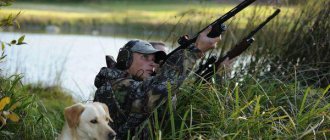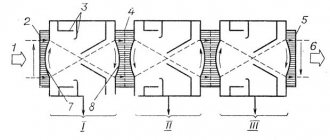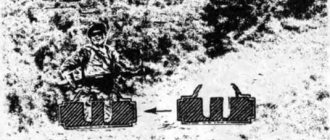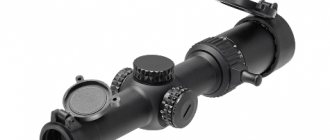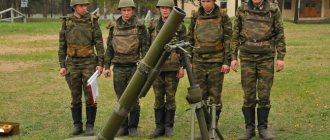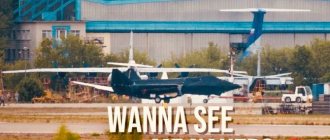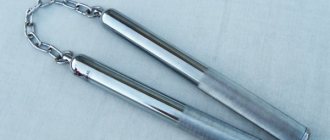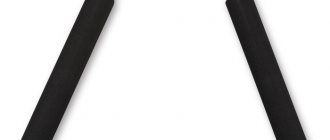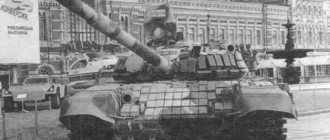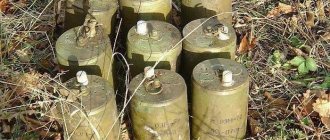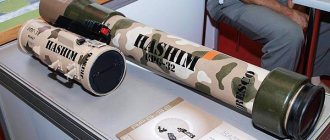Yukon Sightline N475S
Yukon brand night vision device - Sightline N475S. The scope is suitable for hunting in low light. Installed on 12 gauge hunting rifles.
Main characteristics of the night sight:
- digital (image on AMOLED display);
- 1280x720 (matrix) / 1024x768 (display);
- 50mm (objective lens diameter);
- F2 (aperture);
- 6-24x (magnification);
- 5 cm (eye relief);
- 350-400 meters (MAX observation range);
- 940 nm (invisible radiation of the IR illuminator);
- battery 4800 mAh or 4xAA;
- 31.5 cm (length);
- 1.15 kg (weight);
- $800 (price).
Pros:
- works at temperatures from -20 to +40;
- universal landing tire;
- Zoom Zeroing mode (fine aiming).
Minuses:
- has no video output;
- “sees” poorly in snow, rain, fog.
GENERATIONS OF LIGHT-ENHANCED NVGs
Currently, in all countries, the following generational classification applies to NVGs: 1st, 2nd, 3rd, 4th generations (as well as intermediate ones, designated by the “+” sign, for example, 2+). Western manufacturers use the term “Gen” to designate generations.
Generations of NVGs differ in the type of electronic filling. The operating principle of the entire range of NVD models is the same: the available radiation - visible, near-IR or infrared - is captured, amplified by electronic conversion and then projected onto a miniature display. Technical details are understandable only to initiates and are not important for the average user, since servicing of devices, except for the simplest, can only be performed by qualified specialists. For an ordinary fighter, it is enough to understand the differences between generations of NVGs at the level of consumer properties.
The first to become widespread in the US Army were the M-3 “Sniperscope” infrared sights (also known as “Snooperscope”), produced during World War II and the Korean War, which represented the zero generation of NVGs. For the sights to work, additional IR illumination was required from a special flashlight, which was usually attached to the weapon along with the sight. Sights were most often installed on M-1 30-caliber carbines, since these weapons were lightweight and had low recoil. Bulky, vulnerable to mechanical impact, and with a short range compared to modern systems, the 0th generation “Sniperscope” sights nevertheless provided an advantage over the enemy who did not have such NVGs at their disposal.
Pulsar Digex N455
The Pulsar scope is the Digex N455. The device is active during the day and at dusk. Withstands recoil of 6 thousand J.
Description:
- digital;
- 1280x720 / 1024x768 (matrix/display);
- 4-16x (multiplicity);
- 40-50mm lens;
- F2 (aperture);
- 5 cm (removal of i/z);
- 940 Nm LED (laser);
- 500 m (max. observation distance);
- 41 cm;
- 900 grams;
- APS2 battery;
- $1,350.
Advantages:
- video recording;
- Wi-Fi;
- synchronization with smartphone;
- “frame in frame” function.
Flaws:
- To store information you need to additionally buy a memory card;
- high price.
USE OF NVGs
Before you begin the practical use of NVGs, it is absolutely necessary to receive full instruction and undergo a period of training. A person equipped with NVGs retains, at best, 25% of their daytime performance. However, achieving even this level requires significant experience with NVGs. Thus, those using single photocathode NVGs, such as the AN/PVS-7B/D models, will need extensive practice in acquiring depth of visual perception by estimating the relative size of objects. In addition, practice should include practicing adequate immediate actions in case the device fails.
When it comes to caring for your NVD, treat the device the same way you would treat expensive binoculars, following the recommendations in the attached instructions for precautions and preventive maintenance. Use protective covers that will protect the optics from scratches. If possible, do not expose the devices to temperatures above 50 degrees Celsius, in particular, do not leave them in direct sunlight or in a hot car trunk. Turn on the device at least once a month, store batteries separately from the night vision devices (batteries may leak).
NVDs operated in conditions of high humidity or dampness must be regularly purged with nitrogen, which requires special equipment and training. For most, this means periodically sending the device to an authorized service center. Finally, over time, it may be necessary to replace the electron-optical converter due to deterioration in consumer qualities due to long life and/or severe operating conditions.
Yukon Pulsar Phantom BW
Night vision device - Pulsar Phantom BW. Withstands the recoil of a 12 gauge hunting rifle.
Main features:
- 2+ generation image intensifier;
- 60mm/f68 (lens);
- 4x (multiplicity);
- 50 mm (removal of i/z);
- 700 meters (visibility);
- 805nm (infrared illumination);
- AA/CR123 (battery);
- 32 cm;
- 1.2 kg;
- 1400 dollars.
Pros:
- gain of 23 thousand;
- frame detail.
Minuses:
- high price;
- does not have the properties of a thermal imager (does not react to body temperature).
ATN X-Sight-4k Pro, 5-20x
Dear customers, we present to your attention the night ATN X-Sight-4k Pro, 5-20×80 from American Technology Network. This ATN rifle scope is a phenomenal, innovative digital optical device that is ready for use 24 hours a day, 7 days a week. Digital sight with intelligent control from the Smart HD line, model ATN X-Sight 4K Pro with 2 day/night operating modes. Has a smooth zoom from 5 to 20 times. The latest 4K matrix with a resolution of 3864x2218. ATN Obsidian IV Dual Core processor. The landing diameter of the rings is 30mm. Impact resistance to large calibers. Lightweight control system. New energy-saving consumption scheme. Options: ability to record photos and videos, ballistic calculator with aiming point correction, distance measurement, Wi-Fi, Bluetooth, USB type C, electronic compass and barometer, gyroscope, accelerometer, automatic shot recording system (RAV), microSD card up to 256 GB , “one shot” zeroing function. The mechanism for mounting the sight on a weapon has become even simpler - it is now mounted on widely used standard rings with a diameter of 30 mm. Various image color schemes: day, 2 night (black and white and green), various crosshair color marks. The RAV system is a “recorder” mode, when recording is carried out continuously, but the moment of the shot and the previous 10 seconds are saved. With this function, you will never forget to turn on the recording, no matter how unexpected the situation may be, the system will do everything for you. Built-in ballistic calculator, with the ability to program several profiles for different weapons and calibers. One-shot shooting function. Wi-Fi and Bluetooth modules for connecting external devices and accessories In 2022, it introduced day-night sights in a new version. There have been a huge number of changes in the design, all in a positive direction. ATN listened to customers and corrected the shortcomings of the old version of their “X-Sight”. There are many changes and we advise you to familiarize yourself with them, as this is truly a new generation of sights that will outshine the usual optics and most professional night sights. The ATH 4k Pro 5-20x sight is the top version of night vision sights for hunting, with a smaller viewing angle, but with larger optics and increased zoom. We recommend this device if your shooting will start from 100 meters and beyond, or for small game, for comfortable aiming. The most important change has been made to the image transmission system; now there is no blurred image effect when the sight is quickly moved, since the frame rate has been increased to 60 and 120 Hertz. Specifications: ATN 4K M265 Sensor, 3864 x 2218 Magnification 5 - 20 X Field of view at a distance of 1000 meters 73.1 m Field of view angle 5.0° Lens 80 mm Micro display 1280x720 HD ATN Core Obsidian IV Dual Core System resolution 600 lp/mm Correction per pixel 1/8 "Exit pupil 90 mm Security class IP66 Video recording resolution 1080p at 30/60/120 fps Microphone Yes Micro SD card From 4 to 64 GB 10 class Micro-USB Yes Micro-HDMI Yes Wi -Fi (broadcast, gallery and control) iOS & Android Bluetooth Yes GPS (Geotagging, altitude) Yes 3D gyroscope Yes - GS7 3D accelerometer Yes 3D magnetometer Yes Electronic barometer Yes Smart rangefinder Yes Smart photography solution Yes Recoil-activated video recording (RAV) Yes Electronic compass Yes Smooth zoom Yes Sighting reticles Multiple Patterns & Color Options Ring mount 30 mm (included) Battery life (Li-ion) up to 18 hours IR wavelength 850nm Battery type built-in Lithium Ion Weight g. 1010 g Dimensions 379mm x 76mm x 76mm
The night vision device can be used during the day and at night. It has a smooth ZOOM of 5-10 times, a matrix with a resolution of 4K. It is impact resistant to large calibers. The device has many useful options built in. This includes correction of the aiming point in the ballistic calculator, barometer and electronic compass, accelerometer, automatic shot recording, distance measurement, one-shot zeroing and much more. The device is installed on common standard 30 mm rings. This is the top version of the brand, which has an increased zoom, without the effect of a blurry picture when moving the sight quickly, as well as a frame rate of up to 120 Hz.
Pulsar Digisight Ultra N455
The sight reacts even to weak radiation that the human eye cannot see. Mounted on 12mm caliber shotguns.
Characteristics:
- digital;
- 4x magnification;
- 40mm/f2;
- 1280x720 (matrix);
- 1024x768 (display);
- 940 nm/ LED (IR illuminator);
- 50 mm (distance to eye);
- 500 meters (MAX observation range);
- battery 5000 mAh;
- 37 cm;
- 770 grams;
- $1190 (price).
Advantages:
- “frame in frame” mode;
- video recorder;
Flaws:
- poor visibility in adverse weather conditions;
- high price.
Yukon Gals NS-21
The hunting device “sees” well at dusk and can bring the target closer.
Withstands the recoil of large-caliber weapons.
Peculiarities:
- 2-3 generation image intensifier;
- 3x (multiplicity);
- 60mm/f6 (lens);
- 4.5 cm (distance to eye);
- 550 meters (MAX range);
- 850 nm IR illuminator;
- 22.9 cm;
- 820 g;
- CR123A, AA (battery);
- $2380.
Pros:
- adjusting the brightness of the aiming reticle;
- mount for any brand of weapon.
Minuses:
- does not respond to body temperature;
- high price.
Dedal Venator
Night sight plus thermal imager in one device. Withstands the recoil of large-caliber weapons.
Description:
- thermal imaging;
- 50mm F/1.2 (lens);
- 384x288 (matrix);
- 800x500 (display resolution);
- 2x-4x/3x (digital/optical zoom);
- 4 cm (removal of i/z);
- 1500 meters (MAX range);
- 8-14 microns (spectral sensitivity);
- up to 70 mK (temperature sensitivity);
- 23.1 cm;
- 560 grams;
- 2xCR123(battery);
- $5,000.
Advantages:
- reacts to body temperature;
- Has mounts for different types of weapons.
Flaws:
- high price;
- not used at t -20 degrees Celsius.
Dedal T2.380 Hunter
A sight with the characteristics of a thermal imager for night hunting. The device is made on the basis of high-quality German optics. Installed on shotguns of 7.62-12 mm caliber.
Description:
- thermal imaging;
- 384x288 / 800x600 (matrix / display);
- 50mm/f2 (lens);
- 3.5 magnification;
- 8-14 µm (sensitivity range);
- <70 mK (temperature sensitivity);
- 5 cm (removal of i/z);
- 1200 meters (MAX detection distance);
- 27.3 cm;
- 640 g;
- CR123 battery;
- 5-7 thousand dollars.
Pros:
- used at air temperatures from -40 to +50 C;
- automatic adjustment of basic operating parameters.
Minuses:
- expensive model;
- There is no function for saving selected settings.
The time has long passed when troops gathered in orderly columns on the battlefields and, lined up in ranks, fired “in the direction of the enemy” from muzzle-loading silicon muskets. In the twentieth century, war tactics were already very different from the times of the Napoleonic Wars. And it was constantly being improved - fortunately for this there were a great many armed conflicts in various parts of the world, including two global ones - the First and Second World Wars.
Weapons, troop training, strategy and tactics were improved - fundamental changes in the armies of the world took place throughout this period and are still taking place today. Of course, this was mainly facilitated by scientific and technological progress. And one of the most important developments in this area was the thermal imager.
To understand why a thermal imager has had such a strong influence on fire training and combat tactics, you need to understand what it is.
The relevance of this topic lies in the fact that in the modern world, every developed country is conducting its own developments in the field of military equipment in order to have superiority in various situations, as well as when performing official tasks. These developments are presented at various international exhibitions of weapons, military equipment and ammunition.
The purpose of the abstract is to study modern night and thermal imaging sights in solving fire problems in various situations.
Author's tasks:
- Expand the content of the concept of night vision devices (NVD) and thermal imaging sights;
- Consider thermal imagers used in the US and Russian armies;
- Discuss the advantages and disadvantages of night vision devices and thermal imaging sights, as well as;
- Analyze modern night vision combat systems from Western manufacturers.
The object of the study is military developments aimed at improving the tasks associated with fire training.
The subject of the research is night vision devices, as well as thermal imaging sights aimed at solving fire missions in various situations.
The list of sources includes the works of scientists whose efforts were aimed at studying night vision devices and thermal imaging sights. The abstract also discusses open sources from the Internet and scientific articles.
specializes in the development, prototyping, production, promotion and distribution of military products.
- Concepts of night vision devices (NVD) and thermal imaging sights
Thermal imager
is a passive device that registers thermal radiation and converts it into a format accessible to the human eye. The device is equipped with a display that displays a picture with silhouettes of objects of different temperatures.
Due to the fact that the thermal imager uses the objects’ own radiation to construct images, the operation of the device does not depend on illumination, which distinguishes it from night vision devices based on electron-optical converters. In other words, the thermal imager is capable of “seeing” and recognizing objects in absolute darkness without additional illumination and in adverse weather conditions. The device detects outgoing heat waves through smoke, fog, rain and dust. Due to the fact that thermal imagers operate in the invisible range of radiation, they are insensitive to glare and can be used in any lighting conditions. In this case, the imager is not fixed using optical and optoelectronic detecting devices (“anti-sniper”).
Modern thermal imagers have increased sensitivity and detect temperature differences in the range of 100-50 mK (0.1-0.05 degrees). This is far from the limit, since some models are even more sensitive, which allows you to record the slightest temperature changes and identify “cold” and “hot” zones. Thanks to this, thermal imagers have become widespread in military affairs, as well as in solving fire missions. Thermal imagers have enormous potential and continue to be actively introduced into a variety of areas.
Night vision device (NVD) –
is a class of optoelectronic devices that provide the operator with an image of the terrain (object, target, etc.) in low-light conditions. Devices of this type were widely used in combat operations at night, for conducting covert surveillance (reconnaissance) at night and in dark rooms. Despite the number of advantages they provide to their owner, it is noted that the vast majority of existing models are not capable of providing peripheral vision, which requires special training to use them effectively.
Thermal imaging sight
- specialized equipment that well recognizes any thermal radiation from all objects and even objects caught in the lens. Based on the data received, the built-in processor creates a picture, which is subsequently recognized by a person. Depending on the model, heat waves can be black and white or multi-colored. The basic operating principle of the device is based on the temperature difference between living and inanimate objects.
- Modern thermal imagers used in the US and Russian armies
Thermal imagers in the US Army
The US military has been using thermal imaging technology for decades. Second-generation thermal imaging sights mounted on the M1 Abrams main battle tank, as well as FLIR (Forward Looking Infra Red) devices used on aircraft, are the most common in the US Army. These ground and air systems played a key role in the success of Operation Desert Storm in the early 1990s. With visibility reduced to almost zero due to darkness, sandstorms and smog from burning oil wells, the US military could, however, see and engage enemy equipment and soldiers at considerable distances. By the way, most of the footage shown on television of laser-guided bombs hitting Iraqi targets was filmed using FLIR instruments.
Thermal imagers are more focused on use in military equipment than on small arms. Indeed, even the most compact of these types of devices are bulkier than 2nd or 3rd generation EOI equipment and require a larger power supply to cool the thermal emitter. In addition, TVP is very expensive: a typical military model in this NVD class costs over $10,000. However, more recently, thermal imaging technology has begun to be used in combination with small arms. Thus, the American one has developed a line of thermal imaging devices for infantry. In particular, a sight for small arms weighing 1.77 kg and a range of 800 m, a sight for a heavy machine gun and a grenade launcher weighing 3.2 kg and a range of 1200 m, a reconnaissance device weighing 5 kg and a firing range of up to 2.5 km. The French company CSF has developed Sophie binoculars weighing 2 kg with a human identification range of 1200-1300 m. Based on the photodetector used in this binoculars, a thermal imaging device for controlling various military vehicles, a sight for an anti-tank guided missile (ATGM), a device for correcting fire. Based on the same sub-matrix, a thermal imaging panorama was developed for the commander of the Leclerc tank with a range of up to 2.5 km, an aiming navigation system for a helicopter and a sight for the Leclerc tank with a recognition range of 3.5 km. An example of the simplest thermal imaging device is the American “Life Finder” (aka Game Binder). It is also called a heat seeker. The flashlight-sized device costs several hundred dollars and is designed to indicate the presence and detect warm-blooded creatures by capturing the heat generated by their bodies. According to the results of practical testing of the Life Seeker conducted by the police, the device’s capabilities were rated as very mediocre. In any case, Life Finder can only help locate people, but not in any way identify them or target weapons5.
Thermal imagers in the Russian army
It is interesting that already in the 30s - 40s. in the USSR there were very serious developments in IR devices. In 1939-1940 domestic IR night vision devices “Ship” and “Dudka” were developed and tested for night driving of tanks. Heat direction finders were also created for the Navy. However, then, for some unknown reason, work on creating domestic thermal imagers was curtailed, and the USSR turned from a leader in this industry into a “catching up” one. In the 80s Based on foreign samples, the USSR developed and put into mass production thermal imagers of the zero generation (“Posobie-1”) and first generation (“Posobie-2”, “Agava-2”). T-90 tanks and some modifications of the T-80 are equipped with Agava-2 thermal imagers.
The production of thermal imaging sights for ATGM firing has also been launched. In the 1990s - early 2000s. Military thermal imaging technologies have practically not developed in Russia, which has led to a significant lag behind Western countries in this area. The situation began to improve in 2008, when Rosoboronexport and the French signed 2 contracts. The first is for the supply of 130 modern thermal imagers for installation on Russian T-90 tanks, and the second is for the import to Russia of equipment for the manufacture of sighting systems. Soon a service center for servicing thermal imagers was opened in Vologda, and production of French thermal imagers under license was subsequently launched at the base. In 2010, the first batch of 20 Katrin-FS thermal imagers was released in Vologda. This thermal imager weighs 5.5 kg, produces an image of 754 × 576 pixels, operates at temperatures from -40 to +55 degrees Celsius and provides detection of infantry at distances of 6 km, military equipment - at 10 km, helicopters - at 14 km, and aircraft – at 18 km. At the beginning of 2012, the Novosibirsk Institute of Semiconductor Physics announced that it would soon launch the production of thermal imaging devices of its own design, but whether among them there would be thermal imagers for military or only industrial purposes is still unknown.
- Advantages and disadvantages of night vision devices and thermal imaging sights
Advantages
In this abstract, as we see, foreign manufacturers predominate most in the field of night vision devices and thermal imaging sights, which are made in the form of a monocular. They are more like an optical sight and are designed to be mounted on a rifle or used as a telescope. And the NVG device, the price of which is an order of magnitude lower (10,000 rubles), is binocular, that is, it allows the user to see in the dark with both eyes in real time. As users note in their reviews, this solution is not only convenient, but also allows the owner, through some manipulations with the optical device, to change the tactical and technical characteristics of the device. After all, this is military equipment that is built to last. No expansion cards or tricky devices - an ordinary construction set for a Russian person: metal structures, optical devices and a few wires.
Flaws
Disadvantages of the NVD device Naturally, any product of the military industrial complex has a number of disadvantages, which many users pay attention to. The first disadvantage is the weight of the device. Still, the metal structure of the NVD device makes itself felt.
- Modern combat night vision systems from Western manufacturers
Europe
Europe is home to several manufacturers of combat surveillance systems, including the French company Sagem Defense Securite. This company produces the JIM-LR and JIM-MR models. The cooled JIM-LR surveillance system with a low weight of about 2.6 kg has a sensitivity of 3-5 microns; Despite the cooling pump, this system is very quiet. This feature was demonstrated more than once during night exercises where the JIM-LR was barely audible even when operating in a small, empty room on a quiet night. In addition, JIM-LR has three magnifications: x2, x4 and x8; and the identification distance is about 3.5 km for a tank, and detection of such vehicles is possible at a distance of 9 km.
The Sagem JIM-MR short range model has a wide field of view and 2x magnification in the range of 8-12 µm. This allows the user to detect and identify the tank at a distance of 3.5 and 1 km respectively.
For dedicated surveillance systems, Jenoptik makes a day/night surveillance platform that can be mounted on a tripod, a useful option for continuous operation. Jenoptic notes that this product is ideal for artillery observers along with experienced aircraft builders. For this purpose, the NYXUS model entered service with the German army in 2007.
In addition, Jenoptik is supplying the NYXUS-LR portable thermal imager as part of the German IdZ-ES future infantryman program. NYXUS-LR facilitates 24/7 surveillance and also provides good smoke and dust permeability. The detection range for NYXUS-LR is about 5 km for vehicle and 4 km for identification (vehicle), laser rangefinder also has similar ranges.
The SOPHIE family includes the cooled SOPHIE-MF model, which has three fields of view: narrow, wide and x2 magnification. Thales claims that the thermal imager can operate in extreme conditions, with temperatures ranging from -40°C to +55°C; a useful feature for soldiers using the device in the climate of Afghanistan. One of the attractive characteristics of SOPHIE-MF is that it can be used to detect camouflaged targets.
Binoculars from Vectronix
Customers looking for handheld thermal imaging binocular rangefinders can choose the VECTOR family from Vectronix. In the VECTOR family, the VECTOR-IV model is designed for infantry units, and the VECTOR-21 model is intended for use as a specialized forward vision system.
Israel
Night vision systems of all types and generations are in service with the Israeli army, and over the past 25 years they have played an important role in all military operations. As a result, the Israeli defense industry is now a supplier of advanced systems ranging from soldier glasses to long-range surveillance systems combined with other sensors.
CORAL-CR developed by Elbit Systems Electrooptics El-Op is designed for medium-range surveillance; its tests were carried out in combat units of the Israeli army. According to the company, it is capable of marking and remembering 12-bit coordinates and transmitting them back. CORAL-CR is a lightweight thermal imaging surveillance system with a range of several kilometers, designed for infantry and reconnaissance units. The portable CORAL-CR is designed for simple operations.
ITL's target clientele is mainly ground forces such as infantry, snipers, reconnaissance and special forces. Portable, rugged, and low-energy, modern infantry systems allow you to operate effectively in harsh combat conditions without imposing physical and psychological stress on the soldier. These systems range from individual modular models to entire combat systems optimized for precision operations.
Canada
Beyond the 49th parallel, the Canadian General Starlight Company produces a range of versatile thermal imaging systems for battlefield surveillance. These include the TIM-14 Thermal Imaging Multipurpose Monocular, which has x2 digital zoom and multiple detection ranges depending on the lens size installed in the model. For a 22 mm lens, a person can be detected at a distance of 475 meters and a car at 800 meters, respectively, for a 16 mm lens the ranges are 305 meters and 550 meters, for an 8.5 mm lens the ranges are 170 meters and 300 meters.
Canada is also home to Newcon Optik, which offers a line of night vision devices, laser rangefinders, image stabilization and image enhancement devices. Of particular interest for this article are the TVS-7B and SENTINEL thermal imaging systems. The first model is a pair of glasses that can detect a person at 475 meters and a car at 900 meters using an uncooled sensor. Meanwhile, Newcon Optik's SENTINEL thermal imaging binoculars have very long detection ranges, up to 1 km for a model with a 57 mm lens and 2.5 km for a 115 mm lens. Detection and identification ranges for a tank-sized target are 3,000 meters and 6,000 meters for the 57mm lens and 4,000 meters and 8,000 meters for the 115mm lens.
ITT and night vision
In the field of thermal imaging, ITT Corporation is one of the world leaders among developers, manufacturers and suppliers of helmet-mounted and head-mounted thermal imaging solutions based on a different technology than that described in the main article, namely image brightness enhancement. Its systems are widely used by American and allied forces, as well as national security forces.
The AN/PVS-14 is a lightweight, reliable, high-performance thermal imaging monocular that provides improved resolution for improved mobility and target identification. These rugged devices can be handheld, mounted to a helmet or camera, or attached to a weapon.
conclusions
: The experience of forward observers in modern warfare will have a major influence on the design criteria of forward observation products used in tomorrow's conflicts. The wars in Iraq and Afghanistan were very instructive in showing that forward observers operating on the ground require ever greater ranges to detect and identify targets. This is combined with the desire for next-generation systems to have even more impressive image clarity and improved means of sharing images with other users. More and more advanced systems are needed and companies producing these devices will be forced to solve a serious problem in the future.
Bibliography
- Volkov V.G. The use of active-pulse surveillance devices to see glare elements. Defense Technology Issues, Episode 11, 200
- Geykhman I.L., Volkov V.G. Basics of improving visibility in difficult conditions. M., Nedra-Business Center LLC, 2009.
- Salikov V.L. Night vision devices: history of generations.//Special equipment, 2000, No. 2, pp. 40 – 48. 21 – 32.
- www.monch.com
- www.sagem.com
- www.jenoptik.com
- www.thalesgroup.com
- www.vectronix.com
- www.elbitsystems.com
- www.itlasers.co.il
- www.flir.com
- www.exelisinc.com
- www.controp.com
- www.nvoptics.com
- www.itt.com
Our company provides modern marketing services from product development to product sales.
Pulsar Trail XQ50
Sight and thermal imager in one device. Installed on 12mm caliber hunting rifles.
Description:
- thermal imaging;
- 50 mm/f2 (lens);
- 2.7 (optical zoom);
- 2x4x (digital zoom);
- 384x288 / 640x480 (matrix and display);
- 1800 meters (detection range);
- 5 cm eye relief;
- <40 mK (thermal sensitivity);
- 8-14 microns (spectral range);
- 905 nm laser;
- Li-Ion Battery / 5000 mAh;
- 29.2 cm;
- 710 grams;
- 5 thousand dollars (price).
Advantages:
- Wi-Fi;
- pairing with a smartphone;
- video recording
Flaws:
- expensive device;
- not used at air temperatures below -25 C.
Where can I buy?
The price of a night vision scope largely depends on the type of technology used and additional functionality. The older the generation of the device with an image intensifier and the better the characteristics of the digital device, the more expensive the price. You can buy a product cheaper either with worse characteristics or in used condition.
Purchasing a new device from the Tut.ru store provides the following advantages:
- Warranty and post-warranty support
- Professional advice from experienced hunters and shooters
- Possibility of selecting a mount for a hunting carbine, shotgun, rifle or other weapon from a wide range of accessories presented.
- Convenient payment and delivery methods
In our showrooms in Moscow and St. Petersburg, you can touch a night vision scope with your hands, make sure of its performance and quality, and also compare models from different manufacturers. Our store is a leader in Russia in the field of hunting optics with over 10 years of experience. We deliver night vision scopes by courier in Moscow and St. Petersburg, or by a transport company throughout Russia. Pickup from the office and payment in installments is possible.
ATN Thor HD 384 – 4.5-18Х
A sight with thermal imager properties is suitable for night hunting. The hunter sees a black and white image on the screen. The device is installed on large-caliber weapons.
Main characteristics:
- thermal imaging;
- 384x288 / 1280x960 (matrix and display);
- 50mm/F0 (lens);
- <50 mK (thermal sensitivity);
- 1,500 meters (tracking range);
- 6.5 cm I/O removal;
- 4.5-18x (magnification);
- 22.4 cm length;
- 840 grams;
- 4xAA (battery);
- $6,500.
Pros:
- automatic video recording of a shot;
- Wi-Fi and Bluetooth.
Minuses:
- does not work below -20 °C;
- high price.
RECOMMENDATIONS FOR SELECTING NVGs
There are only two price scales for NVDs: “expensive” and “very expensive”, therefore, when planning to purchase an expensive device, you should understand why you need it, what can, in principle, be obtained from this device, and which manufacturers should be trusted.
Let's consider a number of characteristics that determine the operational properties of NVGs.
The most important property of NVDs is the signal-to-noise (S/N) characteristic In NVGs with a high value of this characteristic, in very poor lighting conditions there is practically no picture interference. In high-quality modern night vision devices, the S/N value should be at least 20.
Resolution (measured in lp/mm) – the number of pairs of lines per mm. The clarity and contrast of the image depends on the resolution. High-quality images are provided by devices with a resolution of 30 lp/mm. The most advanced NVGs have a resolution of 70 lp/mm.
Light sensitivity is one of the most important characteristics of the sensitive layer of the photocathode, measured in hA/lm. In the 1st generation NVD it is 230 hA/lm; 2nd generation – 230-850 hA/lm; 3rd and 4th generations – 1000-2600 hA/lm.
In 3rd generation devices, the photosensitive coating is protected by an ionic barrier (“Film”), which reduces the effectiveness of the coating. There is a so-called transmission index (measured in %), which determines how much the ionic barrier reduces the light sensitivity of the image intensifier. For example, in the 3rd generation image intensifier, the transmission rate is about 36%. This means that a 3rd generation device with a photosensitivity of 1350 hA/lm corresponds to a second generation with approximately 500 hA/lm. More advanced is generation 3 Pinnacle (with a reduced ion barrier, “thinfilmed”). In it, the transmission is increased to 80%. Finally, 4th generation NVGs use 100% light sensitivity (“unfilmed”).
EBI (Equivalent Background Illumination) is the amount of light emitted by the photocathode itself when the device is turned on. The smaller it is, the better. Objects whose illumination is below this indicator are invisible to this night vision device.
In general, the main indicators that determine the operation of NVDs in the dark are the sensitivity of the photocathode, the signal-to-noise value, and EBI.
1st generation device PNV-57e and the image it generates.
There are quite a lot of first-generation NVGs currently offered on the market. Their advantage is low cost. In the CIS, you can buy NVG-57e from old stocks (such a device costs about $200). The quality of their workmanship is very good, which, combined with an affordable price, creates a certain demand for these night vision devices, but one must understand that this is not even yesterday, but the day before yesterday. All 1st generation NVGs come to the market after long-term storage, as a result of which their operational properties are significantly reduced, up to complete loss of functionality. But even a 1st generation NVD in good condition is most likely not suitable for serious work.
For example, the NVG-57e weighs about 2.5 kg, the eyepieces protrude forward by about 30 cm, and this pleasure must be worn on the head! According to user reviews, this NVG is of little use for an infantryman. Firstly, eyepieces of small diameter must be brought close to the eyes, and the required position relative to the eyes must be strictly observed, otherwise the sharpness drops significantly. However, at the edges of the picture the sharpness is poor in any case, in addition, there is a barrel-shaped distortion (distortion) of the picture. Secondly, the viewing angle of the NVG-57e is quite narrow. Thirdly, acceptable visibility starts from 2-3 m - nothing can be seen closer than this distance. Fourthly, the point of view is moved forward by about half a meter, which causes some discomfort for the operator (you can’t see your hands at all). While moving in the dark over rough terrain with the NVG-57e is still possible (albeit risky), aiming and manipulating the weapon is not. This NVG can only be converted and used as night binoculars - for reconnaissance and surveillance. There is also PNV-57a - it is much worse, and its price is only $50, although some sellers are trying to charge the price of PNV-57e for it (but here you need to carefully look at the labeling so as not to be deceived).
The 2nd and 3rd generations are modern devices, and in some cases, the NVD of the 2nd generation may be superior in quality to the device of the 3rd generation. Each device must be approached individually. Foreign and expensive does not mean good, and the technical characteristics may be greatly inflated by the manufacturer.
In general, any NVG that you are going to purchase should first be tested in action. In particular, it is necessary to look at the device for an extended period of time - at least an hour - under conditions that reproduce the actual situation of use, noting the development of any signs of discomfort. The head mounting system (for ONVs) and rubber eyepieces can cause particular inconvenience. It is one thing to briefly evaluate a device, but quite another to use it in a real operation.
ATN Thor HD 384 – 1.25-5X
Device for night hunting. Withstands impact loads of 4000 J.
Description of the night sight:
thermal imaging;
- 384x288 (matrix) / 1280x960 (display);
- 6.5 cm I/O removal;
- 625 meters (MAX range);
- 25-5x (magnification);
- 19 mm /f0 (lens);
- 17.4 cm;
- 680 grams;
- 4xAA (battery);
- 2.5-4.7 thousand dollars.
Advantages:
- video recording;
- pairing with a smartphone;
- temperature sensor;
- smart rangefinder.
Minuses:
- high price;
- cannot be used at temperatures below -25 °C.
Sightmark SM18008 Photon XT
A scope for hunting during the day and in low light. Installed on large-caliber weapons.
Sight description:
- digital;
- 42mm lens;
- 640x480 (resolution);
- 4.6x (multiplicity);
- 810 nm LED IR laser;
- 110 meters (observation distance);
- 669 grams;
- 39.8 cm;
- 400 dollars.
Pros:
- 6 digital grid options;
- Weaver mount;
- video output for video recording.
Flaws:
- no temperature sensor;
- “sees” poorly in unfavorable weather conditions.
Main results and conclusions
Based on the above, it can be argued that currently there are quite effective NVGs for safety and security purposes. With their help, it is possible to ensure even round-the-clock operation, and in the case of using AI NVDs, also operation with reduced atmospheric transparency. This allows you to reliably provide protection from intruders in a wide range of changes in external conditions. The use of such NVGs is advisable for both security workers and special forces soldiers solving complex combat missions in limited visibility conditions.
Night Owl Optics NightShot
Device for day and evening hunting. Can be installed on a pistol, shotgun, rifle.
Main characteristics of the night sight:
- digital;
- 3x (magnification);
- 40mm lens;
- 640x480 (display);
- 250 meters (observation range);
- 37.5 cm;
- 453 grams;
- 4xAA (battery);
- 400-500 dollars.
Pros:
- Weaver and Picatinny mount;
- built-in infrared illuminator.
Minuses:
- poor visibility in rain, snow, fog;
- cannot be used at temperatures below -28 °C.
Advantages of night vision scopes
The ability to accurately hit a target in minimal light conditions is the main advantage of a night vision scope over a classic optical sight. Modern night vision scopes are characterized by high reliability, protection from environmental influences, advanced electronic components and a wide range of additional functionality. Whether it’s hunting wild boar, elk, hare or other game, it will be easy to detect, identify and hit the target at night.
